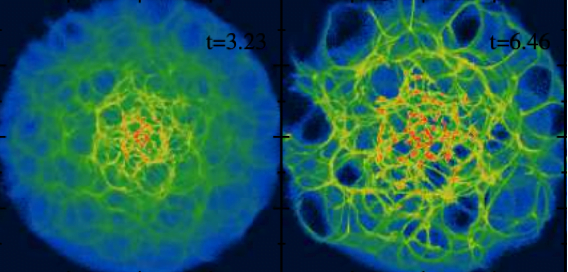Project area/S
- Cosmological Theory
- Epoch of Reionisation
Project Details
Super-massive black holes (SMBHs), millions to billions of times the mass of our Sun, lurk in the centres of galaxies. Understanding where the seeds of these SMBHs come from in the early Universe is an outstanding problem in galaxy formation and evolution.
Some theories suggest that SMBH seeds grew from the successive mergers of stellar mass BHs. The goal of this project is to use models of low-mass galaxies in the early Universe to quantify how quickly we might expect such stellar mass SMBH seeds to grow. The student will investigate the competition between the rate at which a SMBH seed grows and at which stars form in the centre of a low-mass galaxy, and the degree to which internal versus external factors (e.g. stellar and BH winds versus cosmological accretion of gas) might influence this competition. Such competition should arise naturally because the Eddington timescale for BH growth is fixed, while the dynamical timescale for star formation is not, and powerful winds from young massive stars can throttle growing BHs, and vice versa.

Image: Time sequence from a hydrodynamical model of winds from stars in a low-mass galaxy – winds can expel gas from the galaxy and stop the black hole from growing. From Bourne & Power 2016.
This project extends existing work (e.g. Nayakshin et al. 2009, Bourne & Power 2016) in a novel direction and will contribute to a scientific publication.
Student Attributes
Academic Background
Strong physics and mathematics background
Computing Skills
Unix or linux, python and C/C++
Training Requirement
HPC methods and parallel processing
Project Timeline
- Week 1 Inductions and project introduction
- Week 2 Initial presentation
- Week 3 Make predictions for low-mass galaxies without black holes
- Week 4 Implement model for black hole formation and growth
- Week 5 Make predictions for low-mass galaxies with black holes
- Week 6 Examine variation with changes in cosmological gas accretion rate
- Week 7 Examine variation with changes in star formation (rate, mass function) and stellar wind strength
- Week 8 Examine variation with changes in black hole formation (mass function, merger rate) and black hole wind strength
- Week 9 Final presentation
- Week 10 Final report
